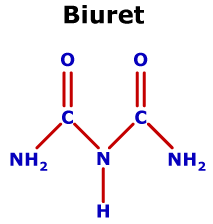Week 3
Protein Sources |
 |
 |
Instructions for listening to audio clips
- Download the QuickTime
Player to listen to the audio files.
- Read the QuickTime
Instructions for installation help.
- Download the RealPlayer to listen to the audio files
- Instructions are on the RealPlayer download page
Nonprotein Nitrogen (NPN) Compounds
-
Text Transcript
Follow along with the audio...
- Introduction
- Nitrogen in form other than peptides or proteins
- Classified
- Organic compound
- Urea, amides, amines, amino acids, and peptides
- Figure 7.7 – Chemical structure of urea

- Inorganic compounds
- Inorganic salts such as ammonium chloride, phosphate, and sulfate
- Feeding
- NPN fed exclusively to mature ruminants
- NPN not fed to poultry, swine, or horses
- Exception: amino acids fed to all species
- Metabolism of NPN compounds
- Rumen microorganisms
- Metabolize NPN compounds to ammonia
- Combine ammonia with carbon chains to form amino acids
- Incorporate amino acids into microbial protein
- Microbial protein
- Digested in abomasum and small intestine
- Absorbed in small intestine
- Metabolized in ruminant tissues
- Factors influencing metabolism efficiency
- Type and number of microorganisms
- Presence of substrates
- Nitrogen source – ammonia
- Energy source - readily available carbohydrates
- Minerals
- Vitamins
- Synchronization of amount and availability
- Urea
- Introduction
- Primary NPN compound
- Figure 7.8 – Feed urea

- CP 281%
- Discussion will focus on urea; may also apply to other NPN compounds
- Optimize use of urea
- Feed only to ruminants
- Supply adequate carbohydrates
- Energy and carbon skeleton
- Provide balanced diet
- Mix feed well
- Do not feed excessive levels
- Limit to 1/3 of total protein in ration
- Feed additional protein sources to young and high producing animals
- Feed small amounts frequently
- Provide transition period
- Provide adequate water
- Methods of delivery
- Mixed in concentrate feeds
- Added to liquid supplement
- Added to salt block
- Combined with silage
- Added to dry roughages
- Slow-release product
- Maximize CP synthesis
- Reduce opportunity for toxicity
- Factors influencing method of delivery
- Protein requirements of animal
- Availability of urea
- Opportunity for toxicity
- Cost
- Availability of energy
- Other protein sources in ration
- Urea toxicity
- Technically, ammonia toxicity
- Typically, over-consumption in short period of time
- Etiology
- Ammonia in rumen exceeds amount able to be metabolized by microbes
- Excess ammonia absorbed
- Ammonia at liver exceeds liver’s capacity to convert ammonia
to urea
- Excess ammonia enters blood stream
- Signs
- Apparent as soon as 30 minutes post-consumption
- Include nervousness, staggering, also kicking at flank
- May also include labored breathing, incoordination, tetany,
slobbering, and bloating
- Treatment
- Early stages
- Acidification of rumen
- Reducing pH, reduces absorption of ammonia
- Outcomes
- Death or survival with few effects
- Fatal dose
- Factors influencing amount of fatal dose
- Animal adapted to urea
- Consumption of other feeds
- Type of diet animal adapted to
- 40-50 g/100 kg of BW in 30 minutes
- Prevention
- Methods to improve urea utilization
- NPN as silage additives
- Increases CP of forage
- Cost-effective
- More information in Module IX
- Extruded grain-urea mixtures
- Starea and GoldenPro
- Energy and slow-release NPN
- Various others on page 106 of text
- Note: data indicate rate of release not primary factor influencing
utilization
- Biuret
- Figure 7.9 – Chemical structure of biuret

- Compared to urea
- More expensive
- Less available
- Less soluble
- More favorable response with low-quality forages
- More palatable
- Cannot be fed to lactating dairy cattle
- Ammoniated feeds
- Organic and inorganic salts used to effectively increase nitrogen
content of feeds
- Feeds include molasses, beet and citrus pulp, cottonseed meal, rice
products, and forages
- Ammoniated liquid feeds
- Ammonium lignin sulfonate
- Fermented ammoniated condensed whey
- Individual amino acid-based products
- Methionine hydroxyl analog, protected methionine, and protected
lysine
- Source of respective amino acids
- Fed to monogastrics and high producing ruminants
|
 |
 |
|



